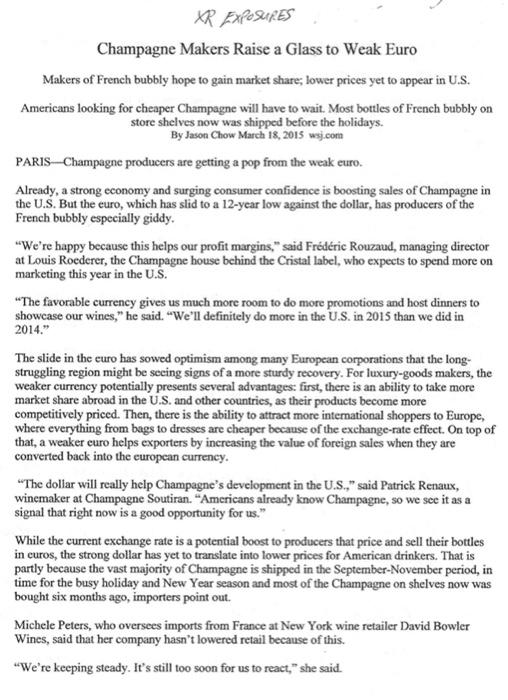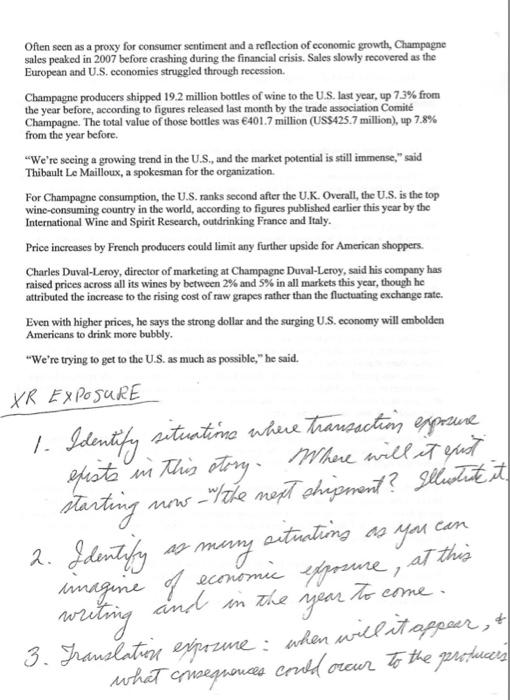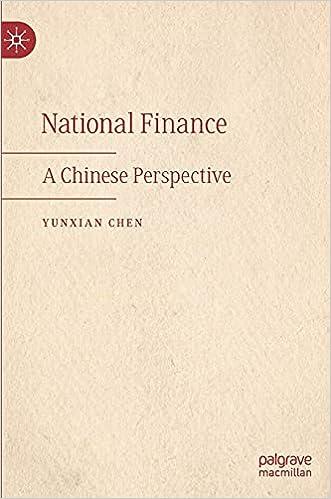XR EXPOSURES Champagne Makers Raise a Glass to Weak Euro Makers of French bubbly hope to gain market share; lower prices yet to appear in U.S. Americans looking for cheaper Champagne will have to wait. Most bottles of French bubbly on store shelves now was shipped before the holidays. By Jason Chow March 18, 2015 ws.com PARIS-Champagne producers are getting a pop from the weak euro. Already, a strong economy and surging consumer confidence is boosting sales of Champagne in the U.S. But the euro, which has slid to a 12-year low against the dollar, has producers of the French bubbly especially giddy. "We're happy because this helps our profit margins," said Frdric Rouzaud, managing director at Louis Roederer, the Champagne house behind the Cristal label, who expects to spend more on marketing this year in the U.S. "The favorable currency gives us much more room to do more promotions and host dinners to showcase our wines," he said. "We'll definitely do more in the U.S. in 2015 than we did in 2014." The slide in the euro has sowed optimism among many European corporations that the long- struggling region might be seeing signs of a more sturdy recovery. For luxury-goods makers, the weaker currency potentially presents several advantages: first, there is an ability to take more market share abroad in the U.S. and other countries, as their products become more competitively priced. Then, there is the ability to attract more international shoppers to Europe, where everything from bags to dresses are cheaper because of the exchange-rate effect. On top of that, a weaker euro helps exporters by increasing the value of foreign sales when they are converted back into the european currency. "The dollar will really help Champagne's development in the U.S.," said Patrick Renaux, winemaker at Champagne Soutiran. "Americans already know Champagne, so we see it as a signal that right now is a good opportunity for us." While the current exchange rate is a potential boost to producers that price and sell their bottles in curos, the strong dollar has yet to translate into lower prices for American drinkers. That is partly because the vast majority of Champagne is shipped in the September-November period, in time for the busy holiday and New Year season and most of the Champagne on shelves now was bought six months ago, importers point out Michele Peters, who oversees imports from France at New York wine retailer David Bowler Wincs, said that her company hasn't lowered retail because of this. "We're keeping steady. It's still too soon for us to react," she said. Often seen as a proxy for consumer sentiment and a reflection of economic growth, Champagne sales peaked in 2007 before crashing during the financial crisis. Sales slowly recovered as the European and U.S. cconomies struggled through recession. Champagne producers shipped 19.2 million bottles of wine to the U.S. last year, up 7.3% from the year before, according to figures released last month by the trade association Comit Champagne. The total value of those bottles was 401.7 million (US$425.7 million), up 7.8% from the year before "We're seeing a growing trend in the U.S., and the market potential is still immense," said Thibault Le Mailloux, a spokesman for the organization. For Champagne consumption, the U.S. ranks second after the U.K. Overall, the U.S. is the top wine-consuming country in the world, according to figures published carlier this year by the International Wine and Spirit Research, outdrinking France and Italy. Price increases by French producers could limit any further upside for American shoppers. Charles Duval-Leroy, director of marketing at Champagne Duval-Leroy, said his company has raised prices across all its wines by between 2% and in all markets this year, though he attributed the increase to the rising cost of raw grapes rather than the fluctuating exchange rate. Even with higher prices, he says the strong dollar and the surging U.S. economy will embolden Americans to drink more bubbly. "We're trying to get to the U.S. as much as possible," he said. XR EXPOSURE 1. Identify situations where transactim espresun exists in this story. Where will it east starting now "Ythe next shipment? Ellestite it 2. Identify situations as you can imagine of economic exposure at this and in the to come. year. 3. Translator expazme : when willstopper, what crusegnomes could crewr to the produces many writing XR EXPOSURES Champagne Makers Raise a Glass to Weak Euro Makers of French bubbly hope to gain market share; lower prices yet to appear in U.S. Americans looking for cheaper Champagne will have to wait. Most bottles of French bubbly on store shelves now was shipped before the holidays. By Jason Chow March 18, 2015 ws.com PARIS-Champagne producers are getting a pop from the weak euro. Already, a strong economy and surging consumer confidence is boosting sales of Champagne in the U.S. But the euro, which has slid to a 12-year low against the dollar, has producers of the French bubbly especially giddy. "We're happy because this helps our profit margins," said Frdric Rouzaud, managing director at Louis Roederer, the Champagne house behind the Cristal label, who expects to spend more on marketing this year in the U.S. "The favorable currency gives us much more room to do more promotions and host dinners to showcase our wines," he said. "We'll definitely do more in the U.S. in 2015 than we did in 2014." The slide in the euro has sowed optimism among many European corporations that the long- struggling region might be seeing signs of a more sturdy recovery. For luxury-goods makers, the weaker currency potentially presents several advantages: first, there is an ability to take more market share abroad in the U.S. and other countries, as their products become more competitively priced. Then, there is the ability to attract more international shoppers to Europe, where everything from bags to dresses are cheaper because of the exchange-rate effect. On top of that, a weaker euro helps exporters by increasing the value of foreign sales when they are converted back into the european currency. "The dollar will really help Champagne's development in the U.S.," said Patrick Renaux, winemaker at Champagne Soutiran. "Americans already know Champagne, so we see it as a signal that right now is a good opportunity for us." While the current exchange rate is a potential boost to producers that price and sell their bottles in curos, the strong dollar has yet to translate into lower prices for American drinkers. That is partly because the vast majority of Champagne is shipped in the September-November period, in time for the busy holiday and New Year season and most of the Champagne on shelves now was bought six months ago, importers point out Michele Peters, who oversees imports from France at New York wine retailer David Bowler Wincs, said that her company hasn't lowered retail because of this. "We're keeping steady. It's still too soon for us to react," she said. Often seen as a proxy for consumer sentiment and a reflection of economic growth, Champagne sales peaked in 2007 before crashing during the financial crisis. Sales slowly recovered as the European and U.S. cconomies struggled through recession. Champagne producers shipped 19.2 million bottles of wine to the U.S. last year, up 7.3% from the year before, according to figures released last month by the trade association Comit Champagne. The total value of those bottles was 401.7 million (US$425.7 million), up 7.8% from the year before "We're seeing a growing trend in the U.S., and the market potential is still immense," said Thibault Le Mailloux, a spokesman for the organization. For Champagne consumption, the U.S. ranks second after the U.K. Overall, the U.S. is the top wine-consuming country in the world, according to figures published carlier this year by the International Wine and Spirit Research, outdrinking France and Italy. Price increases by French producers could limit any further upside for American shoppers. Charles Duval-Leroy, director of marketing at Champagne Duval-Leroy, said his company has raised prices across all its wines by between 2% and in all markets this year, though he attributed the increase to the rising cost of raw grapes rather than the fluctuating exchange rate. Even with higher prices, he says the strong dollar and the surging U.S. economy will embolden Americans to drink more bubbly. "We're trying to get to the U.S. as much as possible," he said. XR EXPOSURE 1. Identify situations where transactim espresun exists in this story. Where will it east starting now "Ythe next shipment? Ellestite it 2. Identify situations as you can imagine of economic exposure at this and in the to come. year. 3. Translator expazme : when willstopper, what crusegnomes could crewr to the produces many writing








